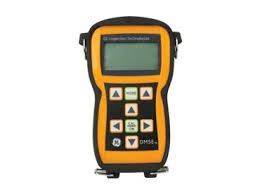GE'S DM5E SERIES WALL THICKNESS GAUGE

A new set of ultrasonic probes has been developed for the DM5E
family to provide the instruments with optimized performance,
even at very high temperatures. The DA5xx series complies with
EN 15317 and includes a 5 MHz standard probe for general purpose
applications, a 2MHz version, for high penetration as well as a
7.5MHz fingertip probe. A newly developed 5MHz high temperature
probe offers an operating range from -10°C up to +204°C. (Standard
probes operate to 70°C)
Both the DM5E and the DM5E DL offer Dual Multi Measurement.
Virtually all components and structures subjected to thickness
measurement will have some kind of protective coating. Such
coatings, including paint, contribute significant error to thickness
measurements of underlying metal walls when using conventional
methods. In addition, the removal of coatings, and their subsequent
reapplication, involves considerable cost and time. With the field
proven Dual Multi feature there is no need to remove any protective
coating. It is only necessary to select Dual Multi mode, place the
probe in position and take the measurement.
The DM5E DL has a built-in datalogger, with a capacity to store up
a massive 50,000 reading in grid and linear files. This makes the
measurement data available for further processing. Using our
UltraMATE software. Measurement data files can be transferred
from the instrument to a PC, where they can be stored and, if
required, printed out in different fixed format reports. Typically, these
can be colour histograms, where ranges of measured values are
colour-coded, or colour can be used to highlight the distribution of
minimum/maximum limit values exceeded. Data can also be pasted
into Windows Clipboard for easy transfer into spreadsheet and word
processing applications.
All versions of the DM5E offer a range of measurement displays.
These include:
• Normal: the thickness value appears as large digits in the centre
of the display.
• MIN Scan: a minimum thickness scan that allows the user to run
the probe over the wall surface. After the evaluation period, the
minimum material thickness measured is displayed.
• MAX Scan: a maximum thickness scan is exactly the same as a
MIN Scan apart from the fact that the maximum thickness
measured is displayed.
• DIFF/RR%: compares the measured thickness with a
user-specified nominal thickness. The dimensional difference
between the two values is displayed, as is the percentage
difference.
• B-Scan: displays a graphic representation of a B-Scan showing
minimum thickness values. The graph is derived by measuring
and recording at 1 point per second.
Download files
